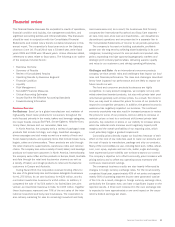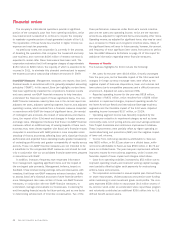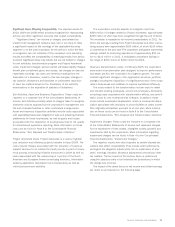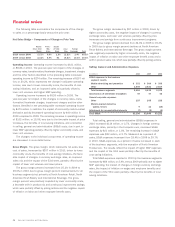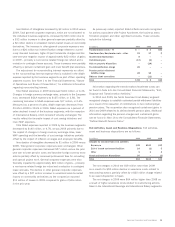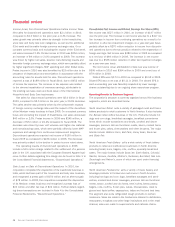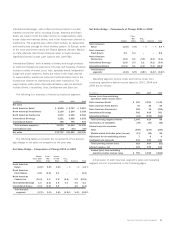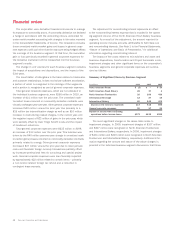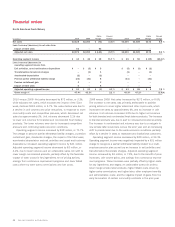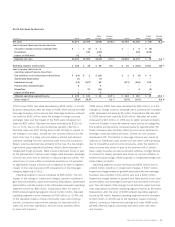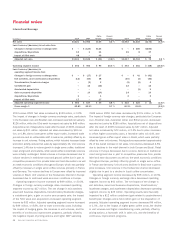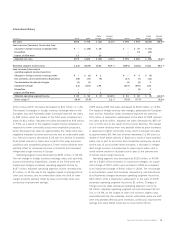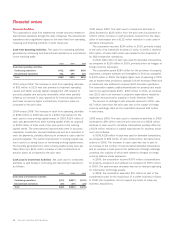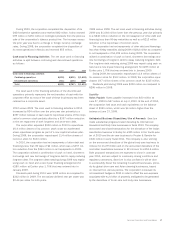Sara Lee 2010 Annual Report Download - page 29
Download and view the complete annual report
Please find page 29 of the 2010 Sara Lee annual report below. You can navigate through the pages in the report by either clicking on the pages listed below, or by using the keyword search tool below to find specific information within the annual report.
•Foreign Earnings – The 2009 effective tax rate was 8 percentage
points lower than 2008 as a result of a $ 44 million change in the
corporation’s global mix of earnings, the tax characteristics of the
corporation’s income, and the benefit from certain foreign jurisdic-
tions that have lower tax rates.
Income (Loss) from Continuing Operations and Diluted Earnings Per
Share (EPS) from Continuing Operations Income from continuing
operations in 2010 was $642 million, an increase of $417 million
over the prior year. The improvement was due to a $270 million
after tax decline in impairment charges and improved business
segment results. Income from continuing operations in 2009 was
$225 million, which was $501 million higher than 2008 due to a
$538 million after tax reduction in impairment charges.
The net income (loss) from continuing operations attributable
to Sara Lee, which excludes the results of noncontrolling interests,
was income of $635 million in 2010 and $220 million in 2009 and
a net loss of $280 million in 2008.
Diluted EPS from continuing operations was $0.92 in 2010 and
$0.31 in 2009 versus a loss of $0.39 in 2008. The diluted EPS
from continuing operations in each succeeding year was favorably
impacted by lower average shares outstanding as the corporation
has been repurchasing shares of its common stock as part of an
ongoing share repurchase program. The corporation repurchased
36.4 million shares in 2010, 11.4 million shares in 2009 and
19.7 million shares in 2008.
Discontinued Operations The results of the corporation’s household
and body care and Mexican meats businesses, which have been
classified as discontinued operations, are summarized below:
In millions 2010 2009 2008
Net sales $2,126 $2,000 $2,502
Income from discontinued
operations before income taxes $÷«254 $÷«245 $÷«317
Income tax expense on income
from discontinued operations (453) (90) (81)
Gain (loss) on disposition of
discontinued operations
before income taxes 158 – (23)
Income tax (expense) benefit on
disposition of discontinued operations (74) – (1)
Net income (loss) from
discontinued operations $÷(115) $÷«155 $÷«212
Sara Lee Corporation and Subsidiaries 27
•Receipt of Contingent Sales Proceeds – In 2010, the corporation
recognized a tax benefit of $47 million related to its receipt of non-
taxable contingent sales proceeds pursuant to the sale terms of its
European cut tobacco business in 1999, compared to a $53 million
benefit in 2009. The 2010 payment represented the final payment
under the sales agreement and, as a result, this is the final year
the corporation will recognize a tax rate reduction related to the
contingent sales proceeds.
•Foreign Earnings – The 2010 effective tax rate was 8 percentage
points higher than 2009 as a result of a change in the corporation’s
global mix of earnings, the tax characteristics of the corporation’s
income, and the benefit from certain foreign jurisdictions that have
lower tax rates. As specifically highlighted in Part I. Item 1A. Risk
Factors, of the corporations Form 10-K, the corporation expects that
its effective tax rate will be impacted in future fiscal years as a
result of its global mix of earnings.
2009 vs. 2008
In 2009, the corporation recognized tax expense
on continuing operations of $133 million, or an effective tax rate of
37.3%, compared to tax expense of $120 million in 2008, or an
effective tax rate of 76.6%. The significant components impacting
the change in the corporation’s 2009 effective tax rate are as follows:
•Goodwill Impairment – The 2009 effective tax rate was 153
percentage points lower than the prior year as a result of a $548 mil-
lion reduction in non-deductible goodwill impairments recognized
during the year.
•Remittance of Foreign Earnings – The 2009 effective tax rate
was 56 percentage points lower than the prior year as a result of
a $63 million reduction in tax charges related to the repatriation
of earnings from certain foreign subsidiaries.
•Finalization of Tax Reviews and Audits and Changes in Estimate
on Tax Contingencies – The 2009 effective tax rate was 55 percent-
age points higher than the prior year as a result of an $74 million
reduction in benefits resulting from the resolution of tax audits,
the expiration of statutes of limitations, and changes in estimate
on tax contingencies, in various countries and various state and
local jurisdictions.
•Receipt of Contingent Sales Proceeds – The corporation
recognized a tax benefit of $53 million related to its receipt of non-
taxable contingent sales proceeds pursuant to the sale terms of its
European cut tobacco business in 1999, compared to a $46 million
benefit in 2008. The 2009 effective tax rate was 15% lower as a result
of this income. In 2008 the effective tax rate reduction was 29%.




